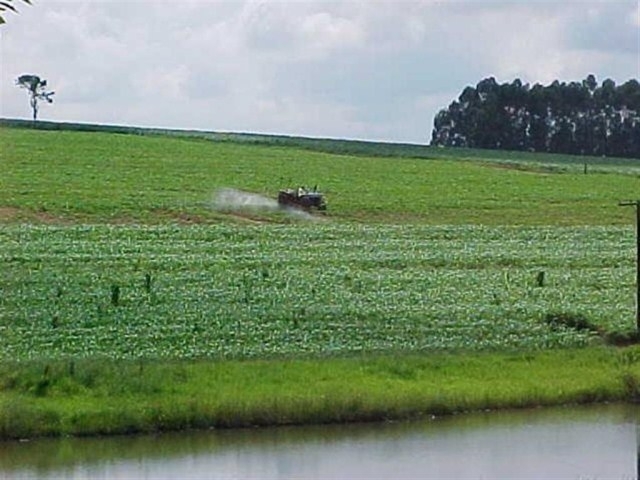

Results from a FAPESP-funded study were published in a Spanish government scientific journal (photo: Embrapa archives)
Results from a FAPESP-funded study were published in a Spanish government scientific journal.
Results from a FAPESP-funded study were published in a Spanish government scientific journal.

Results from a FAPESP-funded study were published in a Spanish government scientific journal (photo: Embrapa archives)
By Diego Freire
Agência FAPESP – The most recent edition of the Spanish Journal of Agricultural Research, a scientific journal published by the National Institute for Agriculture and Food Research and Technology of Spain’s Ministry of Economy and Competitiveness, offers a mathematical model capable of estimating the amount of gray water required to dilute concentrations of pesticide mixtures in water, thus reducing risks posed to the aquatic environment. The model was developed by researchers at the Brazilian Agricultural Research Corporation (Embrapa).
The term “gray water” is used to refer to wastewater generated by various processes, from water used in showers and baths to water used in industrial production. In agriculture, gray water is one component of the water footprint, which is the sum of all water involved in production. The water footprint includes green water, which is rainwater stored in the soil, blue water (from irrigation), and gray water, which includes pesticides and fertilizers.
The article, “A mathematical model to estimate the volume of gray water of pesticide mixtures” by Lourival Paraíba, Ricardo Pazianotto, Alfredo Luiz, Aline Maia and Claudio Jonsson of the Embrapa Environmental Division in Jaguariúna (SP), presents calculated values of lethal concentrations of various agrotoxins in organisms that are indicators of water quality, such as algae, fish and microcrustaceans, and arrives at the volume of water required to dilute the pesticide load and minimize the risks posed to human and aquatic life.
The development of the model involved support from FAPESP for the research study “Biochemical and hematological changes and accumulation in tilapia by exposure to herbicides mixture of the sugarcane culture,” which provided the theoretical background for estimates of the gray water derived from herbicides used in growing sugarcane for sugar and ethanol production.
For the researchers, the contamination of natural freshwater sources is creating a growing environmental liability that is endangering terrestrial ecosystems. In addition, the increase in agricultural production due to expanding global production of biological energy resources highlights the risk of water shortages. “In any sustainable agricultural system, the quality of freshwater needs to be maintained in order to maintain life in all its forms,” Paraíba said.
The Embrapa model calculates the appropriate values for diluting agrotoxins without damaging water.
Traditionally, these types of calculations require knowledge of the pesticide load used in cultivation and maximum limits of wastewater. However, Brazilian agriculture makes use of a number of pesticides whose maximum acceptable limits are not defined. Furthermore, the classic methods do not account for the effects this wastewater has on aquatic organisms.
The mathematical model developed by Embrapa researchers estimates the volume of gray water that would be needed to protect sensitive aquatic species and indicators of water quality in the environment, in keeping with the criteria established by the European Union.
The model considers the physicochemical characteristics of pesticides, including the recommended doses and the concentrations that cause lethal effects on 50% of the population of aquatic organisms that are indicators of water quality.
As a result, a numerical method was proposed to estimate the total volume of water needed to dilute mixtures of the total volume of pesticides used in agricultural production.
In addition to estimating the volume of water necessary for dilution as well as all the pesticides that could be found, the model also includes a numerical indicator that expresses the volume of gray water produced by each pesticide.
According to Paraíba, these values could be printed on the labels of pesticide products, informing farmers of the volume of gray water that would be generated in using those products.
“This would enable a reduction of these volumes. It would be like what the National Institute of Metrology, Quality, and Technology (Inmetro) does by indicating the energy consumption of a light bulb or a household appliance,” he explained.
Along with an example of the mathematical model, the article published in the Spanish Journal of Agricultural Research lists the 17 most widely used pesticides on sugarcane crops and an estimate of the volume of water required to dilute them in the environment. The full article may be read at: revistas.inia.es/index.php/sjar/article/view/4059.
The study by the Embrapa researchers earned them first prize at the 2012 Brazilian Ecotoxicology Conference sponsored by the Brazilian Society of Ecotoxicology, which is associated with the Society of Environmental Toxicology and Chemistry.
Republish
The Agency FAPESP licenses news via Creative Commons (CC-BY-NC-ND) so that they can be republished free of charge and in a simple way by other digital or printed vehicles. Agência FAPESP must be credited as the source of the content being republished and the name of the reporter (if any) must be attributed. Using the HMTL button below allows compliance with these rules, detailed in Digital Republishing Policy FAPESP.





